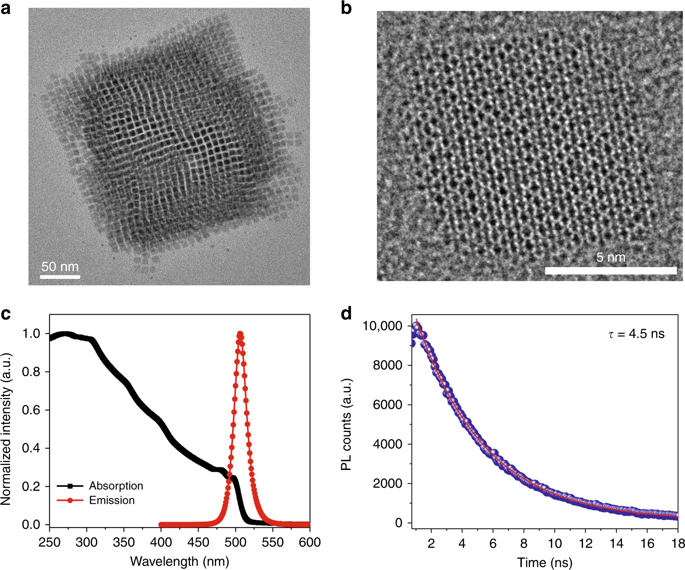Light: Science & Applications ( IF 19.4 ) Pub Date : 2019-10-16 , DOI: 10.1038/s41377-019-0204-4 Chun Hong Kang , Ibrahim Dursun , Guangyu Liu , Lutfan Sinatra , Xiaobin Sun , Meiwei Kong , Jun Pan , Partha Maity , Ee-Ning Ooi , Tien Khee Ng , Omar F. Mohammed , Osman M. Bakr , Boon S. Ooi

|
Optical wireless communication (OWC) using the ultra-broad spectrum of the visible-to-ultraviolet (UV) wavelength region remains a vital field of research for mitigating the saturated bandwidth of radio-frequency (RF) communication. However, the lack of an efficient UV photodetection methodology hinders the development of UV-based communication. The key technological impediment is related to the low UV-photon absorption in existing silicon photodetectors, which offer low-cost and mature platforms. To address this technology gap, we report a hybrid Si-based photodetection scheme by incorporating CsPbBr3 perovskite nanocrystals (NCs) with a high photoluminescence quantum yield (PLQY) and a fast photoluminescence (PL) decay time as a UV-to-visible colour-converting layer for high-speed solar-blind UV communication. The facile formation of drop-cast CsPbBr3 perovskite NCs leads to a high PLQY of up to ~73% and strong absorption in the UV region. With the addition of the NC layer, a nearly threefold improvement in the responsivity and an increase of ~25% in the external quantum efficiency (EQE) of the solar-blind region compared to a commercial silicon-based photodetector were observed. Moreover, time-resolved photoluminescence measurements demonstrated a decay time of 4.5 ns under a 372-nm UV excitation source, thus elucidating the potential of this layer as a fast colour-converting layer. A high data rate of up to 34 Mbps in solar-blind communication was achieved using the hybrid CsPbBr3–silicon photodetection scheme in conjunction with a 278-nm UVC light-emitting diode (LED). These findings demonstrate the feasibility of an integrated high-speed photoreceiver design of a composition-tuneable perovskite-based phosphor and a low-cost silicon-based photodetector for UV communication.
中文翻译:

具有全无机CsPbBr 3钙钛矿纳米晶体的高速变色光电探测器,用于紫外光通信
使用可见-紫外(UV)波长区域的超宽带光谱的光学无线通信(OWC)仍然是减轻射频(RF)通信的饱和带宽的重要研究领域。然而,缺乏有效的紫外线光电检测方法阻碍了基于紫外线的通信的发展。关键的技术障碍与现有硅光电探测器的低紫外光子吸收有关,后者提供了低成本且成熟的平台。为了解决这一技术差距,我们报告了通过结合CsPbBr 3的混合Si基光电检测方案钙钛矿纳米晶体(NCs)具有高的光致发光量子产率(PLQY)和快速的光致发光(PL)衰减时间,可作为UV到可见光的颜色转换层,用于高速太阳盲UV通讯。滴铸CsPbBr 3的容易形成钙钛矿型NC导致高达〜73%的高PLQY,并且在紫外线区域具有很强的吸收能力。与商用硅基光电探测器相比,通过添加NC层,可以观察到响应度几乎提高了三倍,并且太阳盲区的外部量子效率(EQE)提高了约25%。此外,时间分辨的光致发光测量表明在372 nm紫外线激发源下的衰减时间为4.5 ns,从而阐明了该层作为快速色彩转换层的潜力。使用混合CsPbBr 3在日盲通信中实现了高达34 Mbps的高数据速率–与278 nm UVC发光二极管(LED)结合使用的硅光电检测方案。这些发现证明了组合可调谐钙钛矿基磷光体和低成本硅基紫外检测器的高速光电接收器设计的可行性。

























 京公网安备 11010802027423号
京公网安备 11010802027423号